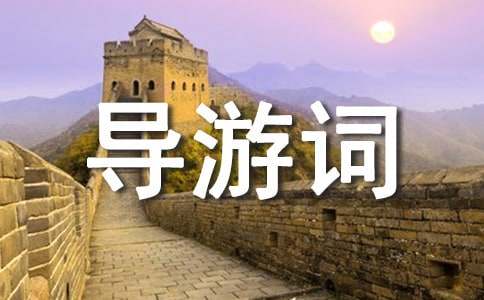英文的导游词
当有外国友人到来时,大家是否能够用流利的英文为对方介绍中国的各地经典呢?以下是YJBYS小编收集的两篇关于中国景点的.英文导游词,欢迎大家阅读。

篇一:中国天安门
Tian’anmen Rostrum
tian’anmen( the gate of heavenly peace), is located in the center of beijing. it was first built in 1417 and named chengtianmen( the gate of heavenly succession). at the end of the ming dynasty, it was seriously damaged by war. when it was rebuilt under the qing in 1651, it was renamed tian’anmen, and served as the main entrance to the imperial city, the administrative and residential quarters for court officials and retainers. the southern sections of the imperial city wall still stand on both sides of the gate. the tower at the top of the gate is nine-room wide and five –room deep. according to the book of changes, the two numbers nine and five, when combined, symbolize the supreme status of a sovereign.during the ming and qing dynasties, tian’anmen was the place where state ceremonies took place. the most important one of them was the issuing of imperial edicts, which followed these steps:
1) the minister of rites would receive the edict in taihedian( hall of supreme harmony), where the emperor was holding his court. the minister would then carry the decree on a yunpan( tray of cloud), and withdraw from the hall via taihemen( gate of supreme harmony)
2) the minister would put the tray in a miniature longting( dragon pavilion). beneath a yellow umbrella and carry it via wumen( meridian gate), to tian’anmen gate tower.
3) a courtier would be invested to proclaim the edict. the civil and military officials lining both sides of the gateway beneath the tower would prostrate themselves in the direction of the emperor in waiting for the decree to the proclaimed.
4) the courtier would then put the edict in a phoenix-shaped wooden box and lower it from the tower by means of a silk cord. the document would finally be carried in a similar tray of cloud under a yellow umbrella to the ministry of rites.
5) the edict, copied on yellow paper, would be made known to the whole country.
such a process was historically recorded as “ imperial edict issued by golden phoenix”.during the ming and qing dynasties tian’anmen was the most important passage. it was this gate that the emperor and his retinue would go through on their way to the altars for ritual and religious activities.
篇二:丽江壁画
Ten kilometers (six miles) northwest of Lijiang Old Town, there are several ancient villages, including Baisha, Dayan, Shuhe, Yangxi and Xuesong. There, the invaluable Lijiang Mural is stored, preserved and displayed in 15 venerable temples, such as Juexian, Wande, Guiyi temples and Sanbi Garden. Altogether, the mural used to include more than 200 pieces of fresco. However, hundreds of years of historical vicissitudes have left only 55 pieces in good condition. The most famous frescos are known as Baisha Mural of the Dabaoji (Great Treasure) Palace and the Colored Glaze Temple (Liuli Dian) in the town of Baisha.
Most of the temples were built from the early days of the Ming Dynasty (1368-1644) to the early Qing Dynasty (1644-1911), and the Lijiang Mural was created at the same time, over the course of about 300 hundred years. In Lijiang, it was an era of rapid economic development, mutual acculturation of multinational culture, and the growth of religions. Accordingly, Lijiang Mural was an artistic representation of this cooperation, communication and progress. The authors of these mural paintings had come from different nations, including the local Naxi Dongba painters; the Taoist painter Zhang from the Central Plain; an Lama artist Guchang; Han painters Ma Xiaoxian and Li Zeng; and many other artists who were unknown to the public
The originality and figures of the mural paintings reflect the different religious cultures and artistic forms of Buddhism, Lamaism, Daoism and the Naxi Dongba religion, as developed in a Naxi school. Therefore, Lijiang Mural is quite different from other frescos. Each painting includes at least one hundred portraits, but perspective is used very well, and the close, middle and establishing images are clear. The various lifelike portraits are not only Buddhas but also ordinary people such as bureaucrats, criminals, tourists and executioners. Many of the scenes and subject matters are drawn from daily life-people are shown fishing, riding horses, weaving, dancing and casting iron. The painters used different methods of portrayal within the different elements of the fresco, such as flesh, garments, jewelry, weapons and many other components. The style of these true-life frescos is rural and unconstrained; the colors are strong and have intense contrast but are also unified. The Lijiang Mural fully demonstrates the superb artistic skills, outstanding creativity and rich imaginations of these excellent craftsmen. The vivid and exact figures, flowing lines, well-defined colors and powerful effects of the exquisite details make the Lijiang Mural not only the rare treasure of art, but also forceful proof of national solidarity and an important source of information for research on national religions, arts and history.
【英文的导游词】相关文章:
北戴河英文专业导游词08-18
开平碉楼导游词(英文)10-30
故宫英文导游词精选10-29
西双版纳英文导游词10-29
海南旅游英文导游词11-04
巴黎导游词英文3篇01-21
华清池旅游专业英文导游词08-18
悬空寺英文导游词10-28
岳麓书院导游词(英文)10-18